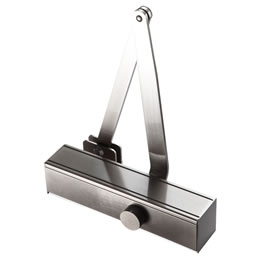
In this blog we will be answering some of our most frequently questions about door closers. These are the questions we hear the most, however we are still happy to answer any other questions you may have, so feel free to pop us an e-mail or give us a call.
What is a Door Closer Used for?
Door closers are used to ensure that a door remains closed after being opened. They close a door in a controlled manner, avoiding slamming. Door closers are fire rated and they are commonly used on fire doors so that the doors remain closed.
How do I fit a Door Closer?
There are three different ways to fit a door closer. Firstly, Figure 1 fixing (pull side or hinge side.) This is the most common method, where the door closer is fixed to the hinge side of the door, the door closer is attached to the door and the closer arm is attached just above the door frame.
The second method of fitting a door closer is Figure 61 fixing (push side or opposite hinge side.) With this method the door closer is attached to the frame of the door, and the arm is attached to the door on the opposite hinge side. For both figure 1 and figure 61 fixings a standard ‘hinge side’ door closer and arm are required.
The last method of fixing is Figure 66 fixing (push side or opposite hinge side) where you will require an ‘opposite hinge side’ guiderail door closer, or for a scissor arm, you would need to use the parallel arm bracket included in the kit. For this method, the door closer is attached to the door and the parallel arm bracket is fitted underneath the door frame head. The arm is then attached to the parallel arm bracket, on the opposite hinge side. For a more in-depth fitting tutorial, see our YouTube video here.
What Tools do I Need to Fit a Door Closer?
The tools you will need to fit a door closer include a drill and drill bits (3.5mm for wood and 5.1mm for metal.) You will also need a pencil, so you can easily mark out where you are going to be putting the door closer. A hammer, a centre punch, a screwdriver, socket wrenches and a cloth or a rag are also required.
Can Anyone Fit a Door Closer?
In order to be able to fit a door closer, you will need some DIY experience and the appropriate materials. Fitting a door closer is not recommended for a first time DIYer, but with a good level of experience, fitting a door closer should not be too difficult. Every door closer comes with a paper template, in which you can easily mark out where the holes will need to be drilled.
Can Door Closers be Adjusted?
Yes, door closers can be adjusted. It is easy to adjust a door closer with just a ladder and a screwdriver, hex key or small wrench, NOT an electric screwdriver. You will need to make small turns (about 20 degrees) in one of the adjustment screws, this should allow the door closing speed, the door latching speed and the door delay to be altered. Clockwise turns should slow it down, and anti-clockwise turns should speed up the closing speed. For more information on adjusting door closers, see our YouTube video.
What are the Types of Door Closers?
There are 3 different types of door closers, as well as domestic door closers, the different types each have different features. You can see our blog which goes into detail about the different types of door closers and their functions here.
If you have any further questions about door closers or any of our other products, you can send us an e-mail or call us, we are happy to help.
